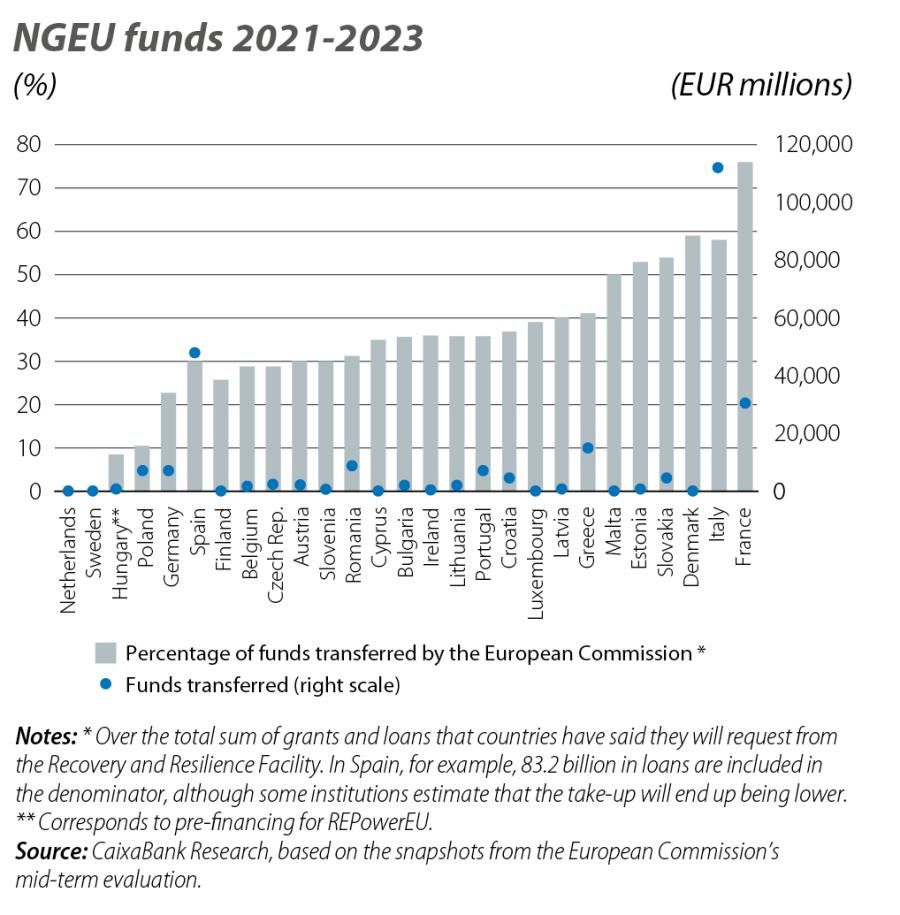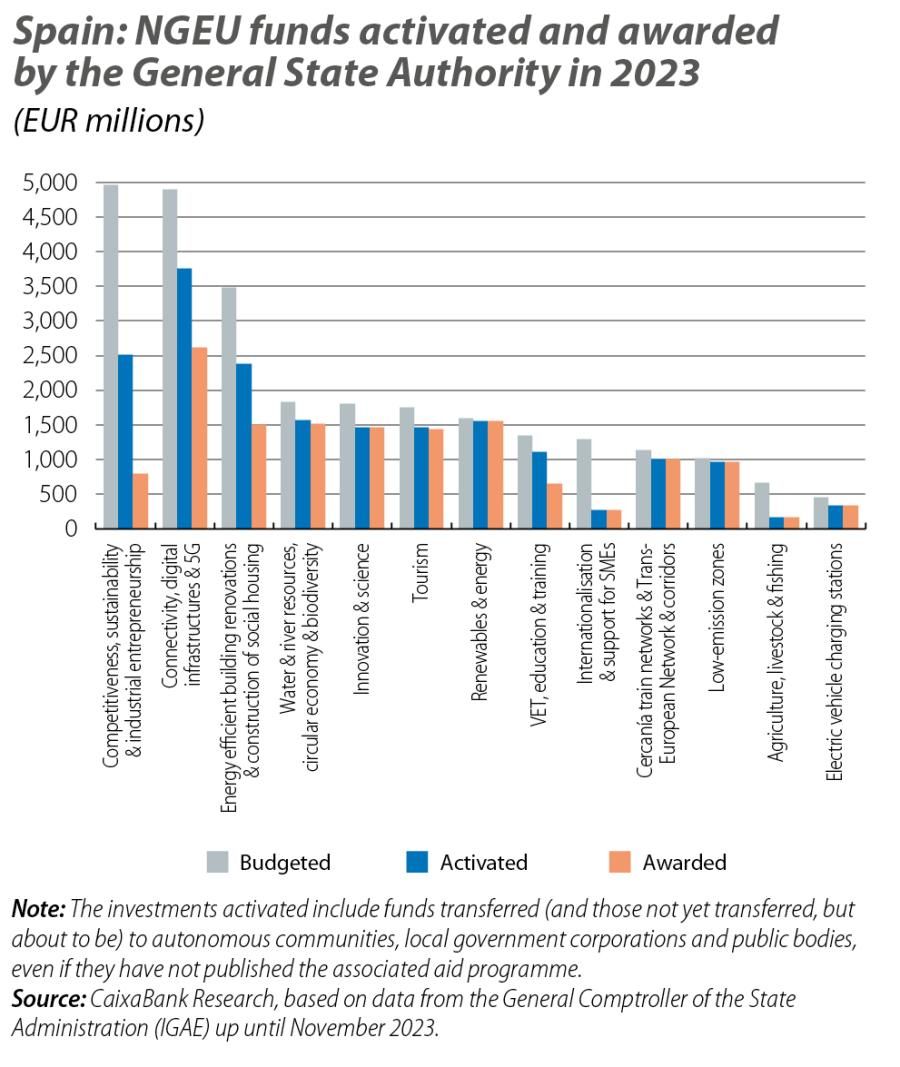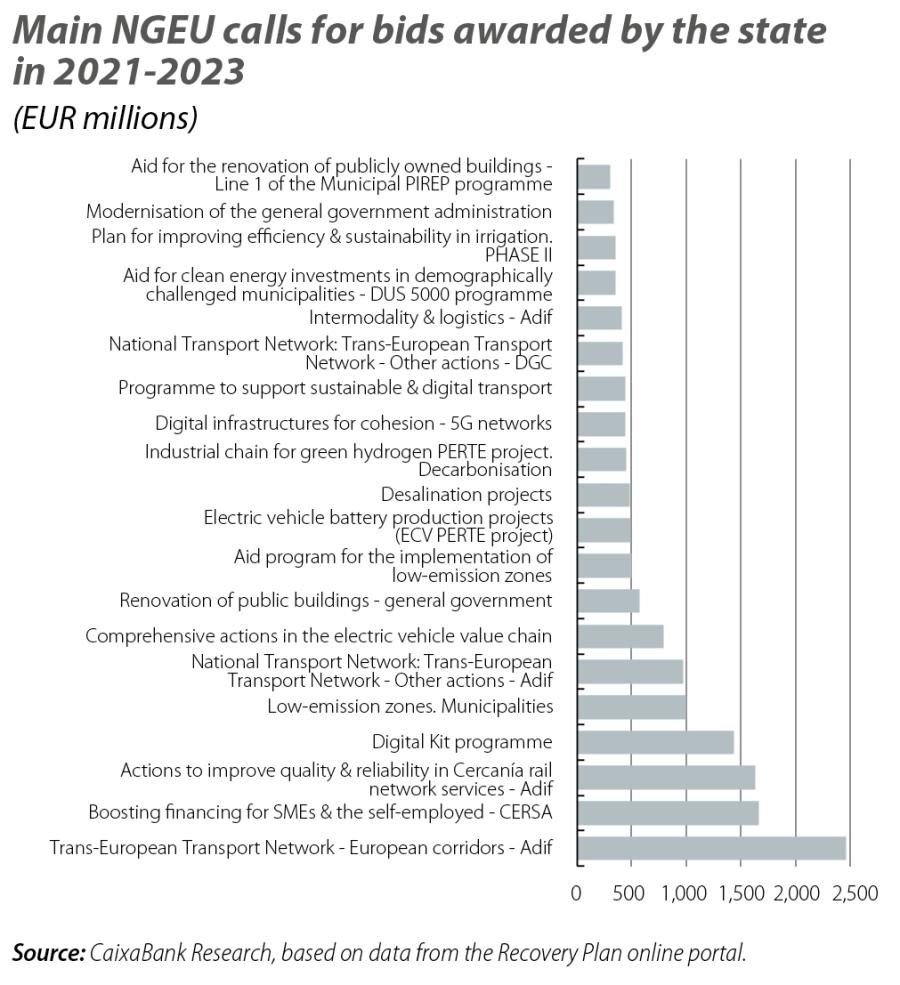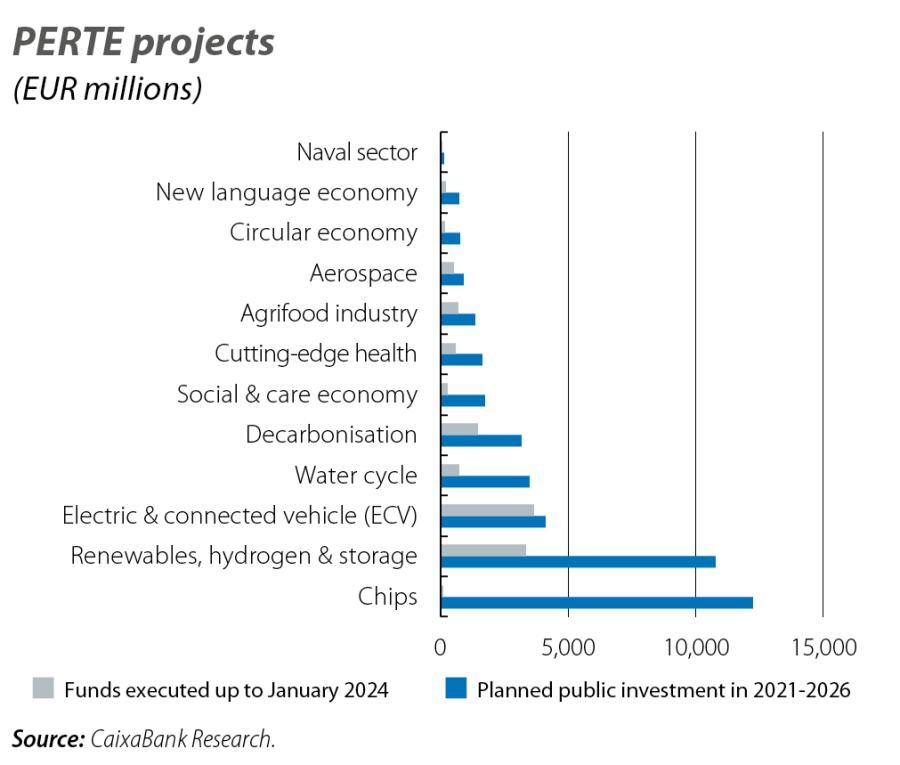Next Generation EU funds: how has the third yearof European funding gone?
With the third year of disbursements of European NGEU funds now behind us. Have expectations been met? Are the investments and reforms being implemented as planned?

With the third year of disbursements of European NGEU funds now behind us, it is time to take stock. Spain included 35.94 billion euros from the Recovery and Resilience Facility – the main instrument of the NGEU programme – in its 2023 General Government Budget, a figure that includes funds from previous budgets that were not allocated at the time. Have expectations been met? Are the investments and reforms being implemented as planned?
The total sum of the subsidies allocated to Spain in the first phase of the Recovery Plan amounts to 69.5 billion, which will be disbursed up until 2026, conditional on certain milestones being met in relation to the materialisation of investments and reforms. Of that amount, to date Spain has received 37 billion from the European Commission. In total, Spain will have access to 163 billion of NGEU funds from the Recovery and Resilience Facility: the aforementioned 69.5 billion will be increased by an additional 10.3 billion in grants from the Addendum and up to 83.2 billion in loans.

Looking at the amount of funds requested from the European Commission by Member States as the NGEU milestones are met (most of which has already been disbursed) relative to the total sum of NGEU funds allocated to each country from the Recovery and Resilience Facility,1 including loans, Spain2 has so far requested a lower percentage (30%) than other economies such as France (76%) and Italy (58%). Two factors that can explain this are the fact that, unlike Italy, Spain has not yet applied for any loans3 and the Commission’s most recent disbursement to Spain dates back to February 2023 (they are currently examining Spain’s request for the fourth payment of 10 billion). However, a comparison in absolute terms reveals that Spain is the country that has received the second most funds to date.
- 1. See the European Commission’s evaluation report of February 2024.
- 2. In the case of Spain, there are 163 billion euros available, including 79.8 billion in grants (69.5 billion in the initial phase plus just over 10 billion in the Addendum) and 83.2 billion in loans that Spain can apply for.
- 3. France has stated that it will not apply for any loans, resulting in a smaller denominator and a higher percentage of disbursements to date relative to the total.
Focusing on the domestic sphere, in 2023 many of the budgeted projects were activated (see second chart), with a total value of around 28.45 billion euros (almost 80% of the amount budgeted for 2023), according to budget execution data. This figure includes calls for grant applications and open competitive tenders, as well as items where funds have begun to be distributed to the regional and local authorities and public institutions responsible for executing investment programs.

However, when it comes to assessing the degree of execution of funds, this estimate is too broad, as it includes projects where funds have been (or will be imminently) made available to the public sector, but in which the final beneficiaries of the associated aid have not yet been confirmed.
If, rather than looking at the projects that have been activated, we focus on the funds that have actually been allocated, we will have a rather more precise idea of the rate at which the investments are reaching the real economy. With this criterion, in relation to the 2023 budget we find that the general government awarded funds amounting to 23.5 billion euros, and that between 2021 and 2023 a total of 66 billion has been awarded, representing 95% of the 69.5 billion that makes up the first phase of the Plan. Although this sum of 66 billion includes around 20 billion euros of calls for grant applications and tenders awarded to private companies and self-employed workers,4 it should be taken into account that a substantial portion of this (over 30 billion) was not allocated to final recipients, but rather directed to autonomous communities,5 local government corporations and public entities and enterprises in order for them, in turn, to launch the corresponding tender processes or calls for grant applications in order to identify the final recipients.
Therefore, delving down one more layer and looking at the amount of funds that has reached the productive economy, this figure will be less than the funds awarded, since there are entities that have not yet designated beneficiaries as well as beneficiaries which have to submit documentation before the payment can be disbursed. If we focus on disbursements by the government to final recipients (i.e. payments to the private sector and payments of direct aid to other public entities excluding those which require a subsequent call for bids in order to award the funds) in relation to the amount budgeted in 2023, we find that up to November the state disbursed some 8.8 billion euros.6 While this amount may seem low, if we consider that there tends to be a surge in expenditure at the end of the year, that payments were also made from funds already awarded but not paid in previous years, and that the autonomous communities also channelled some 2 billion of funds to the productive economy in 2023, we estimate that the total execution7 in 2023 was just over 16 billion euros, compared to 24 billion in the period 2021-2022 as a whole. Thus, the level of execution in this first phase of the Plan has been more than 40 billion, representing 59% of the 69.5 billion available (this figure was 34.5% at the end of 2022). Thus, we can see that the rate of execution is steadily picking up after a somewhat hesitant initial start.
In the third chart, we can distinguish the main calls for bids for NGEU funds awarded by the state between 2021 and 2023. These include railway infrastructure projects, the funding programme for SMEs and self-employed workers through guarantees, the Digital Kit programme to help fund the digitalisation of self-employed workers and SMEs, and programmes in sustainable mobility and urban transformation, as well as in energy with a clear commitment to sustainability (renovation of buildings to improve energy efficiency).
- 4. See the Fourth Recovery Plan Report published by the Ministry of Economy in December 2023.
- 5. In particular, of the 26.5 billion awarded to autonomous communities, the ones that have been allocated the most funds are Andalusia (€4.077 bn), Catalonia (€3.963 bn), the Community of Madrid (€2.875 bn) and the Community of Valencia (€2.471 bn).
- 6. Data to November 2023.
- 7. By execution we refer to funds for the final recipient that have been allocated and justified.

As for the Strategic Projects for Economic Recovery and Transformation (abbreviated in Spanish as «PERTE»), significant progress was achieved in 2023. The calls for bids that have been awarded since the launch of the PERTE projects in 20228 amount to almost 12 billion euros (of which 7 billion correspond to 2023), out of a total amount due to be deployed, including the corresponding funds under the Addendum, of just over 41 billion.
The various PERTE projects vary widely in terms of both their budget and their current degree of execution. Among those allocated the biggest budgets, particularly good progress has been made in the PERTE projects related to electric and connected vehicles (3.67 billion executed) and renewable energies (3.35 billion), while those related to chips and the water cycle, on the other hand, are still in their initial stages.
- 8. These amounts related to the PERTE projects have been included within the total figures for funds awarded mentioned above and are not in addition to those figures.

Looking ahead to the execution of projects in the remainder of 2024, there are many projects underway which we should see crystallise and reach the productive economy. The new budgets should begin to include new funds from the Addendum to the Recovery Plan which will be deployed in 2024-2026 (up to 83.2 billion in loans and 10.3 billion in additional grants), which will largely serve to provide a significant boost to the PERTE projects; indeed, of the 93.5 billion of the Addendum, almost 27 billion will be used to reinforce these projects.
With regard to the reforms required in order to receive the disbursements, the vast majority of the calendar of reforms agreed with Brussels was met in 2023. In particular, the second part of the pension reform,9 the Housing Act, the Jobs Act and the Universities Act were all adopted. The first three were scheduled for the second half of 2022, but were approved in the first half of 2023 and are now being examined by the Commission with a view to approving the disbursement of 10 billion euros requested by Spain corresponding to the fourth NGEU payment. All that remains to be completed is the reform of unemployment benefit, which was rejected by Spain’s Congress in January. For 2024, two additional disbursements are expected: one of 7.2 billion (6.4 billion in grants and 0.8 billion in loans) corresponding to the milestones that were scheduled for the first half of 2023, including the entry into force of a tax reform which is still pending, and another of 18.4 billion (3.6 billion in grants and 14.8 billion in loans) corresponding to the milestones of the second half of 2023. With good progress being made on the reform agenda, the quantitative milestones related to the execution of the investments will take on a more important role, although some of them – such as the number of homes to be renovated or the number of electric vehicle charging stations to be installed – will be examined later than initially planned (in Q4 2024 and 2025, respectively, i.e. a year later than first intended).
If everything that remained outstanding from the 2023 budget is executed in 2024, then the total execution figure for the year could be around 20 billion, meaning that the NGEU programme’s contribution to GDP growth this year could be as high as 0.4 pps. In short, these funds will continue to be one of the key drivers of growth. Beyond the short term, time is of the essence, as the Commission has reiterated that the deadline for all milestones to be met is 31 August 2026. It will therefore be essential to effectively channel the loans under the Addendum and to select the appropriate associated projects in order to make the most of these funds and ensure they have a structural impact which contributes to our economy’s long-term and sustainable growth.
- 9. For a detailed analysis, see the article «Reforming the pension system: in search of sustainability» in the Dossier of the MR06/2023.



